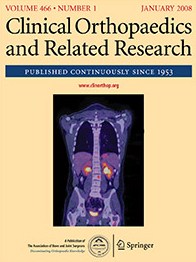
SHOULDER & ELBOW
External rotation immobilization does not reduce recurrence rate for shoulder dislocation
This report has been verified
by one or more authors of the
original publication.
Clin Orthop Relat Res. 2014 Aug;472(8):2380-6. doi: 10.1007/s11999-013-3432-6.
60 patients with a primary anterior glenohumeral dislocation were randomized to either immobilization in external rotation or internal rotation, following reduction. This study aimed to determine whether external immobilization reduced the frequency of recurrent instability as compared to internal immobilization. The results at the minimum 12 months' follow-up indicated that rates of recurrent dislocation, instability, and instability requiring surgical intervention were comparable between groups. Additionally, WOSI scores and ROM (between injured and contralateral side) were similar. Difference in ASES scores between groups achieved borderline significance in favour of external immobilization.
Unlock the full ACE Report
You have access to {0} free articles per month.Click below to unlock and view this {1}
Unlock NowCritical appraisals of the latest, high-impact randomized controlled trials and systematic reviews in orthopaedics
Access to OrthoEvidence podcast content, including collaborations with the Journal of Bone and Joint Surgery, interviews with internationally recognized surgeons, and roundtable discussions on orthopaedic news and topics
Subscription to The Pulse, a twice-weekly evidence-based newsletter designed to help you make better clinical decisions
Exclusive access to original content articles, including in-house systematic reviews, and articles on health research methods and hot orthopaedic topics
Or upgrade today and gain access to all OrthoEvidence content for just $1.99 per week.
Already have an account? Log in


Subscribe to "The Pulse"
Evidence-Based Orthopaedics direct to your inbox.
{0} of {1} free articles
Become an OrthoEvidence Premium Member. Expand your perspective with high-quality evidence.
Upgrade Now













































































